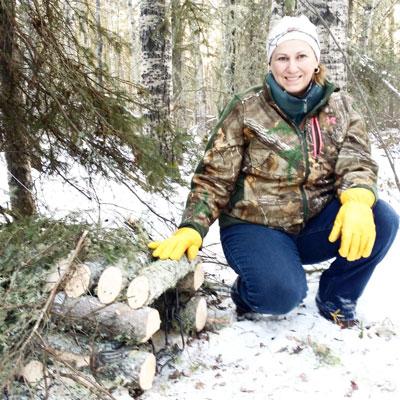Learning traditions and ways of knowing from team members helps the Alberta Energy Regulator to look beyond what we know and work more effectively with Indigenous communities to build relationships based on mutual understanding and trust.
One example comes from our colleague, Annette Hobart, regional engagement specialist and Métis trapper, who operates a trapline near Bonnyville and shares her traditional knowledge with her colleagues to help promote understanding.

“Trapping involves animal harvesting, but it’s more about habitat management,” Annette explains. “We work closely with Alberta Fish and Wildlife to share information and participate in studies. We’ve even assisted in wildlife relocation programs. For example, we recently helped to carefully capture and relocate fishers, a member of the weasel family, to the United States where their population had declined.”
Modern trapping involves the lawful capture and processing of fur-bearing animals. And while the industry isn’t the powerful economic driver as when our country was born, it continues to be an important cultural practice for many Indigenous people.
Today, trapping is a highly regulated activity in Alberta. Traps must adhere to stringent guidelines that are set out in the Agreement on International Humane Trapping Standards and trappers must abide by strict regulations in Alberta. Registered trappers in Alberta are rights holders, allowing them to engage in the regulatory processes of the AER, if they have concerns about a proposed energy development that affects their trapline. However, our role as a regulator extends beyond these processes. In line with the imperative for reconciliation with Indigenous communities, the AER and our employees are listening to and acknowledging diverse perspectives to foster stronger relationships.
Preserving Heritage
The first fur trading post in northern Alberta was established at Fort Chipewyan in 1778 and was built, in part, by Annette’s ancestor who worked for the Hudson Bay Company. In fact, the protection of trapping rights was one of the key interests advanced by First Nations during the negotiation of Treaty 8, which was signed in Fort Chipewyan in 1899.
Today, there are nearly 2 500 registered trappers in Alberta and the province is subdivided into 1 632 Registered Fur Management Areas (RFMA)—commonly known as traplines—administered by the Government of Alberta, First Nations, and Métis Settlements. Each trapline is operated by a Senior Holder, or trapper, who is authorized to work their trapline for a five-year term.
Trapping is a year-round activity, but most trappers operate their line during the fall and winter months.
“Trappers spend most of our year preparing. A lot of our time is spent building and maintaining trails and studying habitat and wildlife trends. My husband and I always start our season with prayer and ceremony,” Annette shared.
To best spend time in the great outdoors, trappers often stage from a dedicated trapper’s cabin—a permanent dwelling with auxiliary buildings like sheds, workshops, and an ever-necessary outhouse.
From their wilderness homebase, trappers carefully and methodically set traps in strategic areas along their trapline.
Annette builds her traps in a way that offers vital information to others in the area. She created a technique that involves building a "fisher box," a type of permanent trap that is covered with natural materials. Fisher boxes help to signal to other land users, including industry, that Indigenous people still use the area for traditional purposes.
The furs are collected and processed at the trapper’s cabin and are bundled and sent to a registered dealer. “Indigenous people also barter between themselves using furs, which has been a tradition for centuries,” Annette said. “The furs are used in dress regalia, jewelry, and hair pieces. Nothing is wasted.”
“Our dances are based on storytelling, stories of warriors and hunting,” she adds. “The furs help tell the story of a life we once had. Being able to display and wear our furs is also about truth and reconciliation; it's connecting us with our past.”
- Annette Hobart, specialist, Regional Engagement.
Trapping is an important activity to transfer culture between elders and youth, and there are several campaigns that strive to preserve the tradition. The Government of Canada’s United Nations Declaration on the Rights of Indigenous Peoples Act – Action Plan is working to expand trapping rights. And, Alberta Health Service's Honouring Life Indigenous Health program has funded programs to train Indigenous youth in trapping. These initiatives expand access to trapping while also preserving traditional knowledge.

Annette works hard to educate young people about trapping. “We go out to the schools, and we talk about trapping and what sustainable trapping looks like. My husband and I have the skill set and we’re willing to share our knowledge. That’s huge to me.”
Trapping has made Annette an advocate for the outdoors.
“I have been able to see things that most people would never imagine witnessing. I’ve seen the birth of a baby deer, and I’ve enjoyed my lunch beside a river otter who sat with me. I’m embedded in my trapline,” she says.


